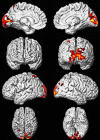Risk factors of neurovascular ageing in women
- PMID: 31397036
- PMCID: PMC6982564
- DOI: 10.1111/jne.12777
Risk factors of neurovascular ageing in women
Abstract
Biological sex and changes in sex hormones throughout life influence all aspects of health and disease. In women, changes in sex hormonal status reflect ovarian function, pregnancy and the use of exogenous hormonal treatments. Longitudinal data from defined cohorts of women will help to identify mechanisms by which the hormonal milieu contributes to cerebrovascular ageing, brain structure and ultimately cognition. This review summarises the phenotypes of three cohorts of women identified through the medical records-linkage system of the Rochester Epidemiology Project and the Mayo Clinic Specialized Center of Research Excellence (SCORE) on Sex Differences: (i) menopausal women with histories of normotensive or hypertensive pregnancies; (ii) women who had bilateral oophorectomy ≤45 years of age; and (iii) women who experienced natural menopause and used menopausal hormone treatments for 4 years. Data from these cohorts will influence the design of follow-up studies concerning how sex hormonal status affects neurovascular ageing in women.
Keywords: aortic blood pressure; brain volume; cognition; menopause; oestradiol; pregnancy; white matter hyperintensities.
© 2019 The Authors. Journal of Neuroendocrinology published by John Wiley & Sons Ltd on behalf of British Society for Neuroendocrinology.
Conflict of interest statement
The authors declare that they have no conflicts of interest.
Figures




References
Publication types
MeSH terms
Grants and funding
- R21 NS066147/NS/NINDS NIH HHS/United States
- R01 AG034676/AG/NIA NIH HHS/United States
- K12 HD065987/HD/NICHD NIH HHS/United States
- R33 AG058738/AG/NIA NIH HHS/United States
- U54 AG044170/AG/NIA NIH HHS/United States
- UL1 RR024150/RR/NCRR NIH HHS/United States
- K99 HL118154/HL/NHLBI NIH HHS/United States
- P50 AG044170/AG/NIA NIH HHS/United States
- RF1 AG055151/AG/NIA NIH HHS/United States
- P01 AG004875/AG/NIA NIH HHS/United States
- R00 HL118154/HL/NHLBI NIH HHS/United States
- R01 AG034676/GF/NIH HHS/United States
- UL1 RR024150/GF/NIH HHS/United States
- RF1 AG057547/AG/NIA NIH HHS/United States
- P01 AG004875/GF/NIH HHS/United States
- U01 AG006786/GF/NIH HHS/United States
- R21 NS066147/GF/NIH HHS/United States
- U01 AG006786/AG/NIA NIH HHS/United States
- R01 HL090639/HL/NHLBI NIH HHS/United States
LinkOut - more resources
Full Text Sources
Medical

